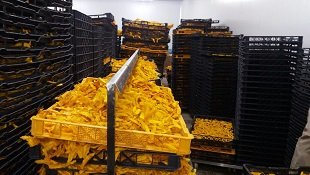

Mangoes, Mangoes and More Mangoes!
One of the primary functions of the farm is growing mangoes. This annual crop fruit allows for the farm to generate a much needed income, it also creates jobs which in turn sustains other families as well. But what happens with all the mangoes once the harvest is over?
The answer depends directly on the market value of different industries that make use of the fruit, and therefore our market distribution might vary and our fruits are sold either to juicing factories, fresh produce market, atchar producers or drying plants.
Walk with me through the drying plant.
When mango's are shipped of to the drying plant, a few fruits from every batch is selected, these are taken to test the sugar content of the harvest - if the sugar content is too high or too low the batch will not be accepted.

The top quality fruits that do make the grade, are then taken into a huge cold-room, while they await their turn to be processed.
The fruits are then washed thoroughly to make sure that there are no contaminants or residues from insecticides on the fruits, then checked for imperfections that might affect the final product, any sub-grade fruit are then taken out and discarded. (This and other unused mango waste gets sold to animal feed producers or farmers in bulk)
The fruits are then moved on a long conveyor belt where more sorting is done before the fruits are dropped in smaller, more manageable crates than the extremely large picking crates that they arrived in. (Like the ones you can see in the picture above.)
The fruits are now ready to be processed.

It is at this point that the entire process of producing dried mango, becomes quite labor intensive.
These smaller containers are now ready to get dispersed to individual workstations, here each fruit will be peeled by hand before moving over to the next workstation where the juicy fruits gets sliced and placed on another conveyor belt that takes them to the packing area.
In the packing area the fruit slices are carefully packed on large flat drying crates, that in turn get stacked on top of each other, on trolleys that gets pushed into the dry-rooms once they are full.

The pictures above might give you a slightly clearer visual of this segment of the drying process.
Once the dry- room is full, it is sealed off and the fruits are allowed to air. This process is done with the help of industrial fans and climate control inside the dry rooms.

Once the fruits are dried, they get removed and a new batch is placed in the dry room to dry.
The dried fruits are then taken to the next workstation where the are sorted through (again) any pieces that does not meet the bill of standards are then removed and the dried mangoes are now ready to be packaged.
The majority of these dried mangoes are exported all over the world, and with a little bit of luck the next time you purchase some dried mango from your local shop, you might find yourself eating a piece that was grown by me!

Happy Eating!!!

